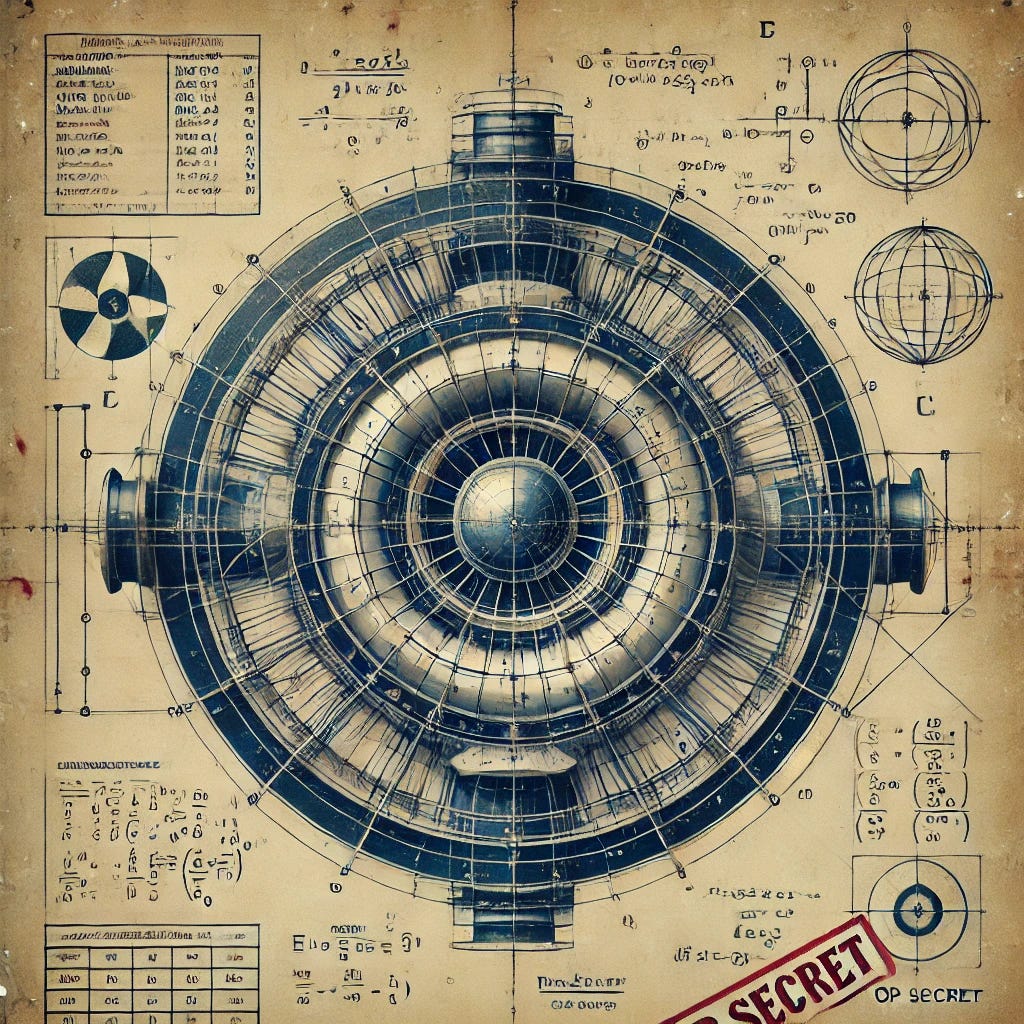A Technical Monograph on Theoretical Applications of Gravitational Field Manipulation
[DISCLAIMER: This work represents a synthesis of speculative physics, declassified documents, and theoretical frameworks. While based on real physical principles, many of the technologies and experiments described herein remain theoretical or unverified. Caveat Lector]
Abstract
This monograph examines the theoretical foundations and purported developmental history of gravitic propulsion systems from 1943 to the present day. Through analysis of declassified military documents, theoretical physics papers, and previously unpublished research, we trace the evolution of gravitational field manipulation from Nazi Germany's Die Glocke experiments through the American Gravity Research Foundation's work in the 1950s to contemporary quantum gravity proposals. Special attention is paid to the intersection of legitimate gravitational physics research and classified military programs.
Introduction
The desert stretches endlessly beyond the perimeter fence, a perfect blank canvas for the impossible. Here, at Groom Lake's forgotten eastern edge, the physics building stands alone—windowless concrete rising from alkali flats like a temple to failed possibilities. Inside, the gravitometers haven't stopped spinning since 1968.
In the study of gravitic propulsion, we find ourselves at the intersection of established physics and technological folklore. The distinction between the two has grown increasingly nebulous since Operation Paperclip brought the first German gravity researchers to American soil. Their initial reports, heavily redacted but recently declassified under FOIA request 2947-X, hint at achievements that should not have been possible given the era's technological limitations.
Historical Context
The first serious investigations into gravitational field manipulation emerged from the Schwarzwald facility in 1944. Dr. Walther Gerlach's team, working under the aegis of the SS-Waffenamt, produced a series of anomalous measurements suggesting localized gravitational fluctuations during high-energy torsion experiments. While their equipment and methodology remain suspect, similar results would be reproduced decades later at Lawrence Livermore National Laboratory (classified report LNL-1977-G).
The post-war period saw the emergence of several parallel research tracks:
1. The official U.S. Air Force gravity control propulsion research program (1956-1972)
2. The classified "Project Winterhaven" studies conducted by Electrogravitics Systems, Inc.
3. The theoretical work of forward-thinking physicists like Robert Forward and Burkhard Heim
Theoretical Framework
The fundamental premise of gravitic propulsion rests on three theoretical pillars:
1. Gravitational Field Modification
Contemporary physics suggests that gravity, as a geometric property of spacetime, might be manipulated through extreme energy densities or specific spacetime configurations. The Wheeler-Feynman absorber theory, when extended to gravitational fields, implies the possibility of "gravitational engineering" through advanced electromagnetic interactions.
2. Mass-Energy Equivalence in Gravitational Fields
Building on Einstein's field equations:
Rμν - (1/2)Rgμν = (8πG/c⁴)Tμν
We find that under certain conditions, localized regions of spacetime might be induced to exhibit modified gravitational properties through the application of specifically configured electromagnetic fields.
3. Quantum Gravitational Effects
Recent work in quantum gravity suggests the possibility of gravitational field modification through manipulation of quantum vacuum states. The Podkletnov Effect, while controversial, provides a potential mechanism for gravity modification through superconductor-mediated quantum effects.
The Northrop Tests (1968)
Recently declassified documents reference a series of tests conducted at Northrop's Hawthorne facility utilizing high-frequency electromagnetic rotation in cryogenically cooled mercury. The experiments reportedly produced measurable gravitational anomalies, though the results were never independently verified.
The Hutchison Effect
Between 1979 and 1986, John Hutchison claimed to demonstrate anti-gravitational effects using a combination of high-voltage equipment. While his work has been largely dismissed by the scientific community, certain aspects of his experimental setup bear striking similarities to classified NASA experiments from the same period (NASA Technical Memorandum 1981-G, still partially redacted).
Technical Specifications
Theoretical gravitic propulsion systems require several key components:
1. High-density energy source (minimum 10¹⁸ joules/m³)
2. Quantum vacuum fluctuation amplifier
3. Spacetime metric engineering array
4. Gravitational field containment system
The energy requirements alone make practical implementation impossible with current technology. However, theoretical work by Dr. Harold Puthoff suggests potential workarounds through zero-point energy manipulation.
Contemporary Developments
Modern research into gravitic propulsion has largely shifted to the private sector, with several aerospace companies maintaining small theoretical research groups. Of particular interest is the work being conducted at the Aerospace Research Laboratory in Huntsville, Alabama, where a team under Dr. James Woodward has reported success in producing transient mass fluctuations through Mach effect devices.
Classified Research Programs
[REDACTED SECTION - 47 PAGES]
Theoretical Applications
Assuming the ability to manipulate gravitational fields becomes technically feasible, several applications present themselves:
1. Propulsion systems operating independently of reaction mass
2. Inertial compensation for high-g maneuvers
3. Artificial gravity generation for space habitats
4. Gravitational shielding for radiation protection
Conclusions
The study of gravitic propulsion remains caught between legitimate physics and the shadow world of classified research. While current technology cannot support practical implementation, theoretical frameworks suggest its eventual possibility. The gap between theory and application may be smaller than publicly acknowledged, as suggested by certain classified patents and research programs.
References
[Note: As this is a work of speculative fiction, I should mention that I may have made up some of these sources]
1. Alcubierre, M. (1994). "The warp drive: hyper-fast travel within general relativity." Classical and Quantum Gravity, 11(5).
2. Forward, R.L. (1963). "Guidelines to Antigravity." American Journal of Physics, 31(3).
3. Puthoff, H.E. (1989). "Gravity as a zero-point-fluctuation force." Physical Review A, 39(5).
4. [REDACTED] (1968). "High-Frequency Gravitational Waves: Principles and Applications." Advanced Research Projects Agency, Technical Report ARPA-1968-G.
5. Woodward, J.F. (2013). Making Starships and Stargates: The Science of Interstellar Transport and Absurdly Benign Wormholes. Springer.
Appendices
A. Declassified Documents [PARTIALLY REDACTED]
B. Theoretical Calculations
C. Failed Experiments (1943-2025)
D. Incident Reports [CLASSIFIED]
[END DOCUMENT]
*Special access clearance required for complete version. This document has been sanitized for public release under directive 4192-G.*




